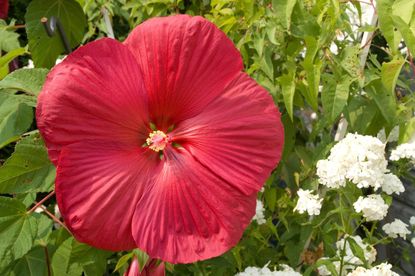Zone 6 Hibiscus Plants – Growing Hibiscus In Zone 6 Gardens


When you think about hibiscus, you probably think about tropical climates. It’s true-- many hibiscus varieties are native to the tropics and can only survive in high humidity and heat. There are also plenty of types of hardy hibiscus varieties that will easily survive a zone 6 winter and come back year after year. Keep reading to learn more about growing hibiscus in zone 6.
Perennial Hibiscus Plants
Growing hibiscus in zone 6 is very easy, as long as you choose a hardy variety. Hardy hibiscus plants are usually hardy down to zone 4. Their sizes vary depending on their species, but as a rule, they’re bigger than their tropical cousins, sometimes reaching heights of 15 feet (5 m.) and widths of 8 feet (2 m.).
Their flowers, too, are much larger than those of tropical varieties. The largest can reach a foot (31 cm.) in diameter. They tend to come in shades of white, pink, and red, though they can be found in other colors.
Zone 6 hibiscus plants like full sun and moist, rich soil. The plants are deciduous and should be pruned back in the fall. After the first frost, cut the plant back to a foot (31 cm.) high and pile a thick layer of mulch over it. Once there’s snow on the ground, heap it on top of the mulch.
If your plant isn’t showing signs of life in the spring, don’t give up hope. Hardy hibiscus is slow to come back in the spring and may not sprout new growth until the soil reaches 70 degrees F. (21 C.).
Hibiscus Varieties for Zone 6
Perennial hibiscus plants that thrive in zone 6 include a wide variety of species and cultivars. Here are a few especially popular ones:
Lord Baltimore – One of the earliest hardy hibiscus hybrids, this cross between several native North American hardy hibiscus plants produces striking, solid red flowers.
Gardening tips, videos, info and more delivered right to your inbox!
Sign up for the Gardening Know How newsletter today and receive a free download of our most popular eBook "How to Grow Delicious Tomatoes."
Lady Baltimore – Bred at the same time as Lord Baltimore, this hibiscus has purple to pink flowers with a bright red center.
Kopper King – Developed by the famous Fleming brothers, this plant has enormous pink flowers and copper colored leaves.

The only child of a horticulturist and an English teacher, Liz Baessler was destined to become a gardening editor. She has been with Gardening Know how since 2015, and a Senior Editor since 2020. She holds a BA in English from Brandeis University and an MA in English from the University of Geneva, Switzerland. After years of gardening in containers and community garden plots, she finally has a backyard of her own, which she is systematically filling with vegetables and flowers.